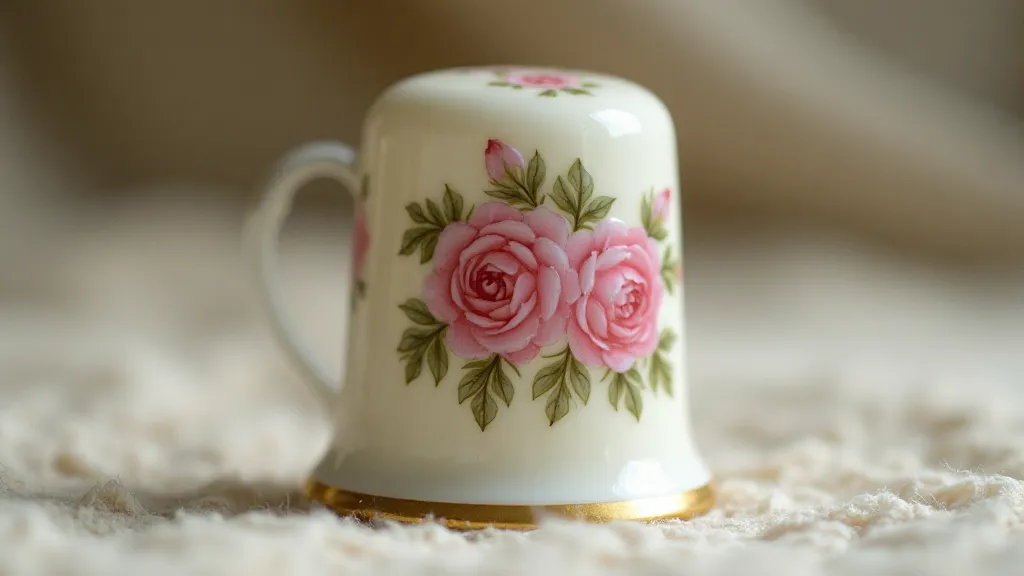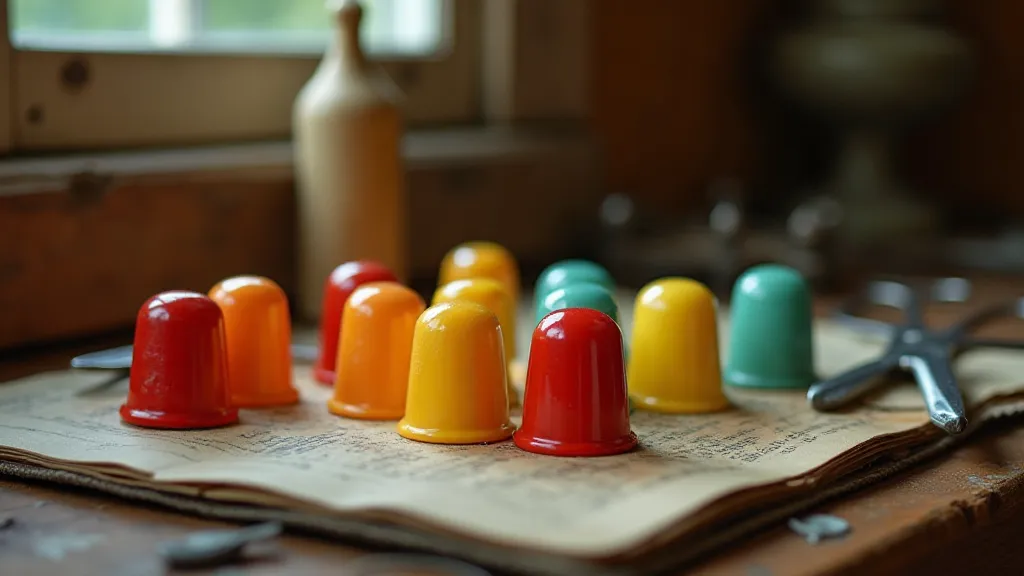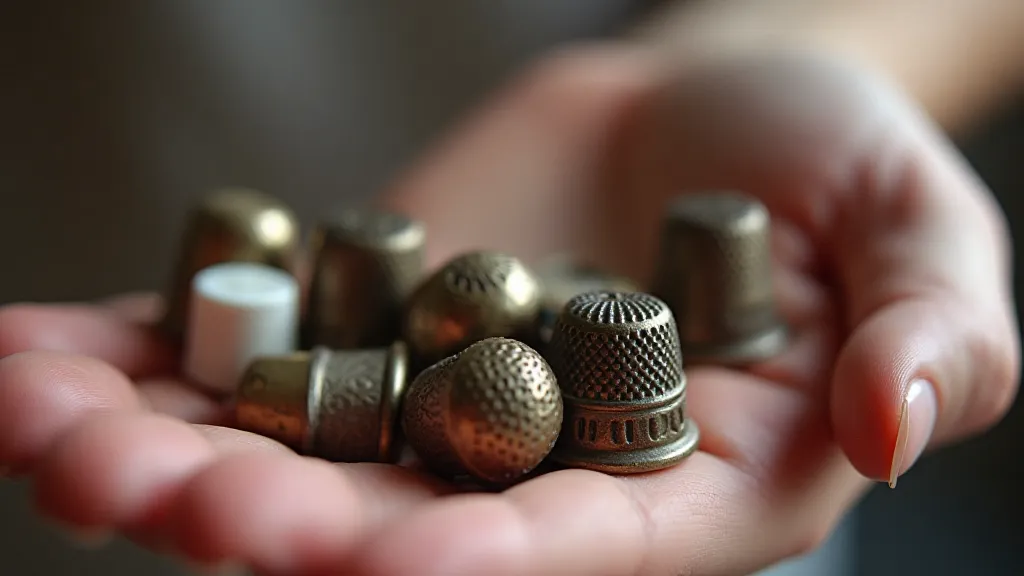A Tapestry of Time: How Thimble Design Reflects Wider Textile Trends
There’s a quiet intimacy in holding an antique thimble. More than just a practical tool, it’s a tiny, tangible link to the past – a miniature monument to the tireless hands of seamstresses, tailors, and countless others who shaped the fabrics of our lives. These aren't mere objects; they're echoes of creativity, testaments to a dedication to craft that transcends generations. And if you truly look, you'll see that their design isn't born in a vacuum. The artistic motifs and styles that swept across broader textile design – the floral exuberance, the geometric precision, the romantic sentimentality – often found their way, beautifully miniaturized, onto these beloved sewing accessories. Let’s unravel this fascinating connection, exploring how thimble design reflects wider textile trends through time.
My grandmother, Elsie, was a seamstress. I remember, as a child, watching her nimble fingers, guided by a worn silver thimble, transforming scraps of fabric into quilts and dresses. She never spoke much about her past, but I could feel the history woven into her every stitch. Her thimble collection, a motley assortment of sizes and materials, felt like a secret window into her world, and into the eras that had shaped her skills. It sparked a lifelong fascination – a desire to understand not just the thimbles themselves, but the stories they held about the artistry of their time. Thinking about the societal significance and history tied to these objects made me realize how many things are passed down through generations, and how these small objects can carry immense historical weight; it truly made me contemplate the miniature pantheon of thimbles and their societal rites.
The Regency Era: Floral Flourishes and Delicate Details
The Regency period (1811-1820), synonymous with Jane Austen and an appreciation for refined elegance, significantly influenced textile design. Think of the delicate floral prints adorning Regency gowns – intricate roses, delicate forget-me-nots, and graceful lilies. These motifs were directly translated into thimble decoration. Porcelain thimbles from this era often feature hand-painted floral arrangements, meticulously rendered in vibrant colors. The focus was on capturing a sense of natural beauty and feminine grace. Many were decorated with delicate gilding, further emphasizing the luxury and refinement of the time. These aren't simply decorated thimbles; they're miniature portraits of a fashionable era.

Victorian Splendor: A Celebration of Ornamentation
The Victorian era (1837-1901) was a period of unprecedented industrial growth and societal change, and this was reflected in textile design. A love for ornamentation and intricate detail became the hallmark of Victorian aesthetics. Think of the richly embroidered fabrics, the dense floral patterns, and the popular Arts and Crafts movement’s emphasis on hand-crafted beauty. This exuberance translated directly into thimble designs. Silver thimbles became increasingly popular, often adorned with engraved floral motifs, intricate scrollwork, and even tiny depictions of landscapes or animals. Jet, a dark gemstone, was frequently incorporated into mourning jewelry and, occasionally, thimble decoration – a poignant reminder of the era’s preoccupation with loss and remembrance. The level of detail achieved is astonishing when you consider the tools and techniques available at the time. Often these intricate details represent the enduring value of handmade objects, a concept that connects directly to what many feel about precious heirlooms – the idea that beyond the material, there's an intangible value to heirloom thimbles.
I recall finding a particularly stunning silver thimble at a local antique market – a tiny masterpiece with a meticulously engraved honeysuckle vine winding its way around the rim. It felt less like a sewing tool and more like a precious heirloom. The craftsmanship was breathtaking, a testament to the skill and dedication of the silversmith.
The Arts and Crafts Movement: A Return to Simplicity
As a reaction against the excesses of Victorian ornamentation, the Arts and Crafts movement (roughly 1880-1920) championed a return to simplicity and hand-crafted artistry. This influence is seen in thimble design through a shift towards more geometric patterns, stylized floral motifs, and a greater emphasis on the natural beauty of the materials themselves. Pewter thimbles became more common, often decorated with simple, repeating patterns or abstract designs. The focus was less on lavish embellishment and more on creating functional objects of quiet beauty. This era also saw an increase in the popularity of wooden thimbles, reflecting the movement’s commitment to natural materials. The skill and dedication required to produce these objects also speaks volumes about the respect for artisans and the importance of preserving that legacy.
Early 20th Century: Machine-Made Precision and New Materials
The early 20th century brought significant advancements in manufacturing technology, leading to the mass production of thimbles. While this made them more accessible, it also resulted in a homogenization of design. However, even in this era of industrialization, artists and craftspeople continued to create unique and beautiful thimbles. Bakelite, a revolutionary new plastic, entered the scene, offering vibrant colors and novel design possibilities. Often brightly colored and boldly patterned, Bakelite thimbles reflect the optimism and energy of the Roaring Twenties. The shift to machine production, while improving accessibility, also drastically changed the processes behind creating these objects. Many felt a loss of the traditional methods and a disconnect from the artistic processes – a sentiment shared by many who feel a connection to the silent chorus of sewing and collecting, each reflecting a unique perspective on history and craftsmanship.

Collecting and Preservation: Appreciating a Legacy
Collecting antique thimbles isn't just about acquiring objects; it's about preserving a tangible link to the past. When handling a vintage thimble, remember that it represents countless hours of labor, dedication, and creativity. Proper storage and care are essential for preserving these delicate treasures. Avoid exposing them to extreme temperatures or humidity, and handle them with clean hands to prevent damage from oils and dirt. A gentle polishing with a soft cloth can help to restore their luster, but avoid harsh chemicals or abrasive cleaners.
Restoration is a delicate matter and should only be attempted by experienced professionals. Improper restoration can devalue a thimble and damage its historical integrity. The real value lies in understanding the context of the thimble – the era it represents, the materials it's made from, and the hands that created it. The stories they tell are incredibly important, and ensuring their preservation involves more than just keeping the objects intact; it requires understanding the historical context and the craftsmanship involved.
My grandmother’s thimbles, now carefully stored in a velvet-lined box, represent more than just sewing accessories. They are tangible links to her past, to a time when craftsmanship was paramount and artistry was interwoven into the fabric of everyday life. They remind me that even the smallest objects can hold the greatest stories – a tapestry of time, meticulously stitched together, waiting to be rediscovered.

The study of thimbles is fascinating as an interdisciplinary field. It blends history, textile arts, anthropology, and material culture, providing a unique lens through which to examine societal values and technological advancements. The evolution of the thimble mirrors the evolution of sewing traditions throughout history. And as we continue to appreciate and preserve these delicate treasures, we also honor the countless individuals who dedicated their lives to the craft of sewing and the creation of beautiful and functional textiles. Their legacy lives on in the intricate designs of antique thimbles and the countless stories they have to tell. And as we pass these treasures down to future generations, we ensure that their stories continue to inspire and delight for years to come. The small details woven into these objects are what make them so unique.
As we continue to appreciate and preserve these delicate treasures, we also honor the countless individuals who dedicated their lives to the craft of sewing and the creation of beautiful and functional textiles. Their legacy lives on in the intricate designs of antique thimbles and the countless stories they have to tell. And as we pass these treasures down to future generations, we ensure that their stories continue to inspire and delight for years to come. The small details woven into these objects are what make them so unique.
As we continue to appreciate and preserve these delicate treasures, we also honor the countless individuals who dedicated their lives to the craft of sewing and the creation of beautiful and functional textiles. Their legacy lives on in the intricate designs of antique thimbles and the countless stories they have to tell. And as we pass these treasures down to future generations, we ensure that their stories continue to inspire and delight for years to come. The small details woven into these objects are what make them so unique.





